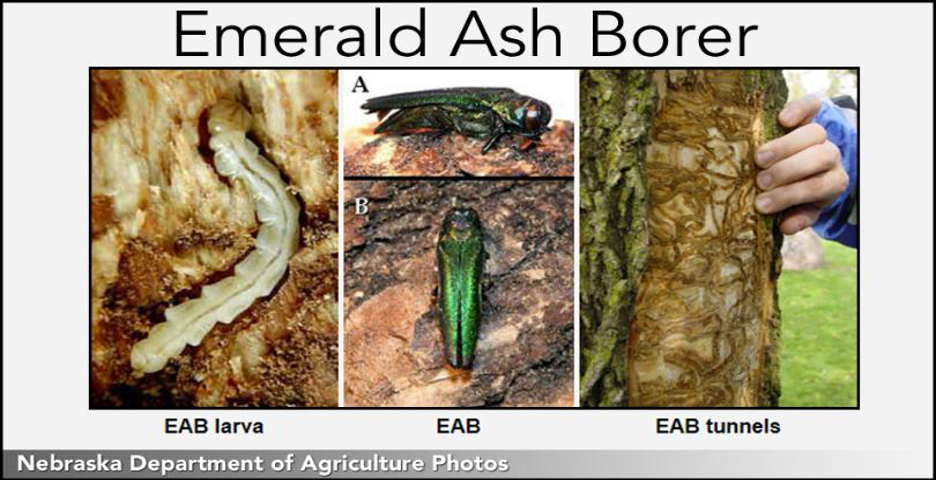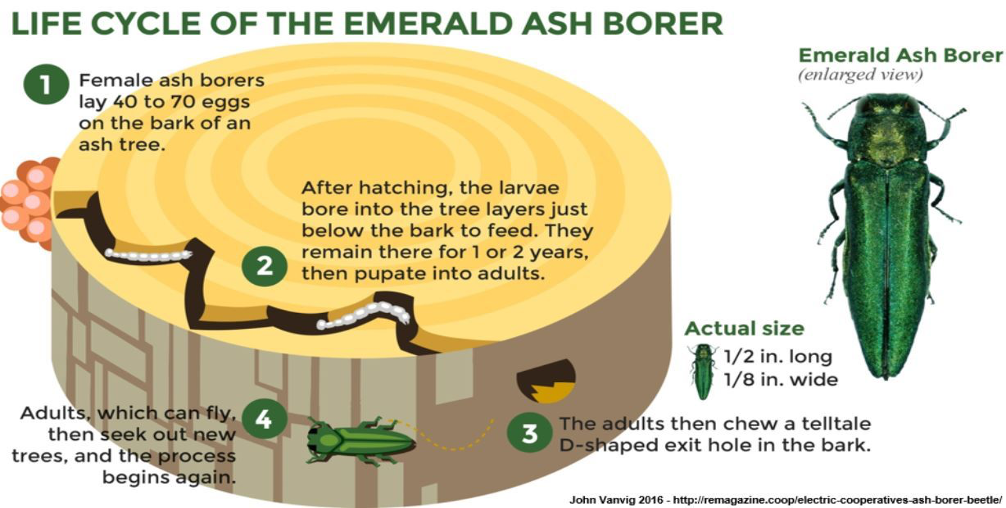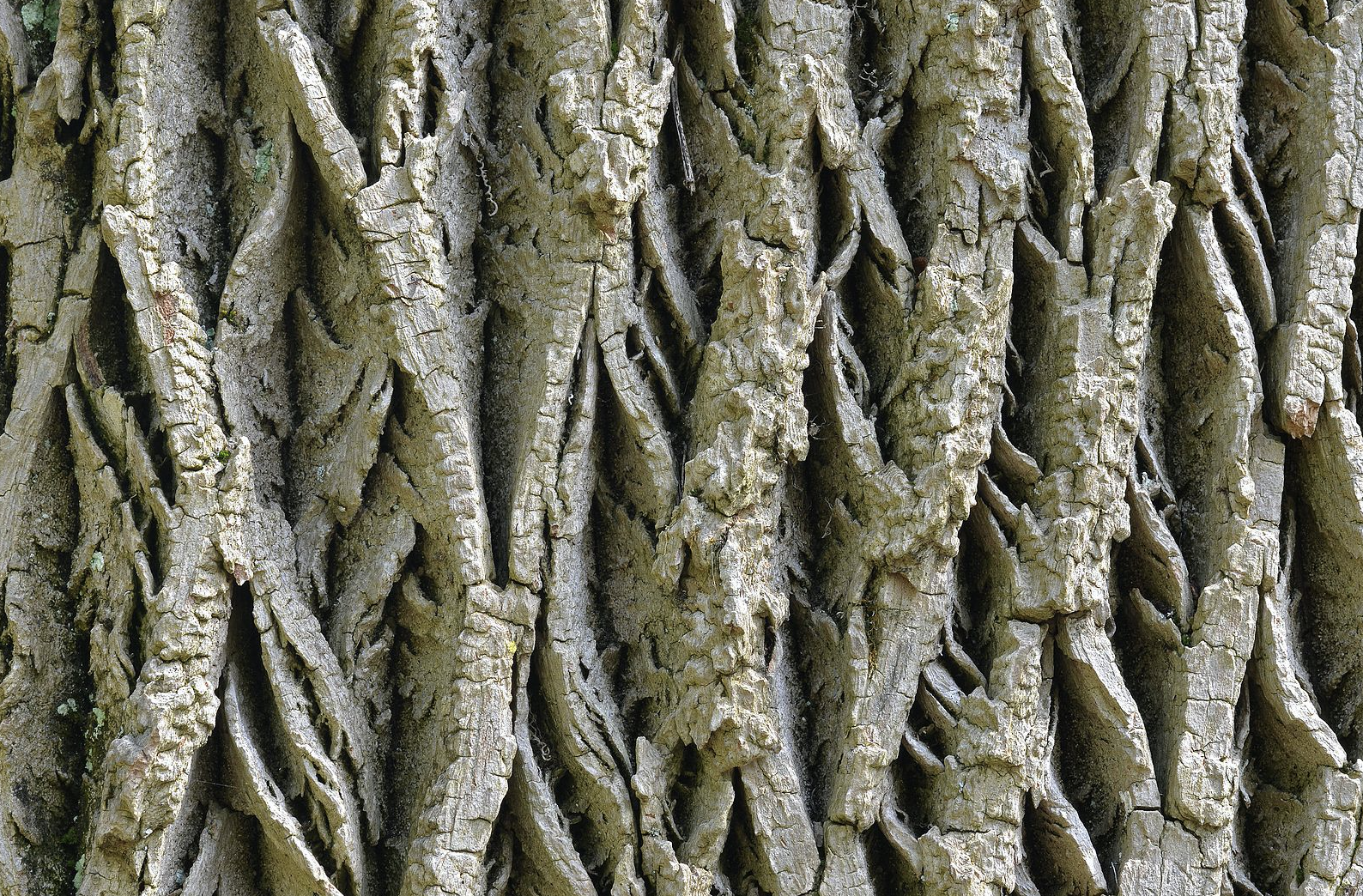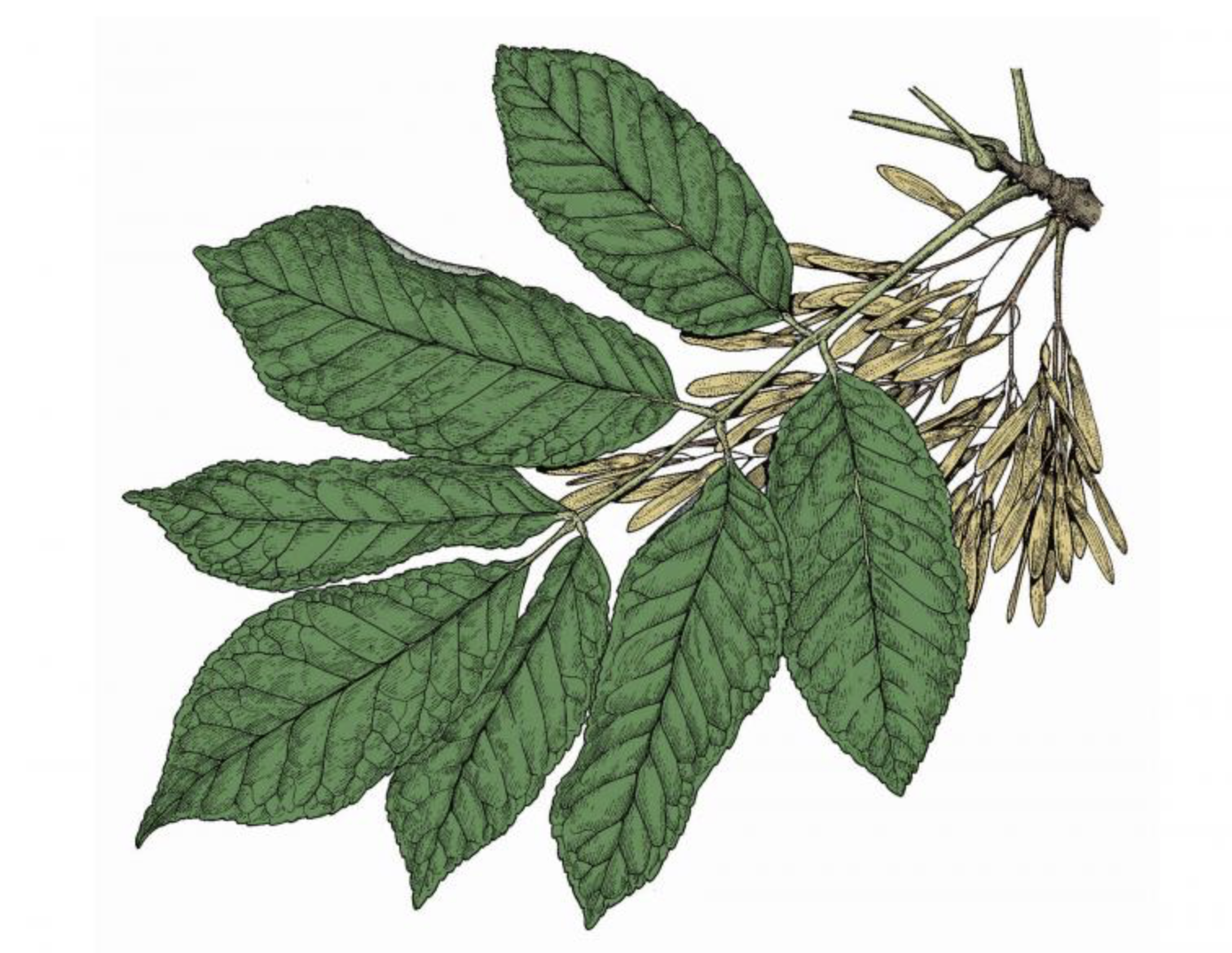By Nick Streczywilk
The Emerald Ash Borer (EAB) is a beetle smaller than a penny that preys upon ash species such as the white, black, blue, and green ash that call Western New York forests their home. The Western New York region is primarily inhabited by white ash (Fraxinus Americana), when speaking in terms of ash, so this is the focus. After the rapid expansion of the EAB from its original introduction in Michigan, it found itself in New York in the early 2000s. An adult borer lays her eggs under a flap of bark or in a crack in the bark. Once hatched; the larvae bore into the tree and eat its outer bark and soft inner tissue, which disrupts the transportation of water and other vital nutrients throughout the tree (fig.1). Once the larvae mature into adults, they feast on the canopy of the White Ash (Kashian 2011). This defoliation is the first sign that a tree is infected with these insects and the second, subtler hint, are tiny “D” shaped holes where the beetles exit the tree. Once visible defoliation is noticeable; the tree may only have 2-4 years left to live.
The insect enacts close to a 95% death toll on ash that it interacts with. The containment and eradication of the borer were aggressively pursued by national, state, and local agencies. Bans on the transportation of firewood across state lines were enforced as well as laws in NYS that allowed for firewood to only travel within 50 miles of its harvest location within state boundaries. The infected individuals can receive an insecticide treatment that helps kill the borer, but this is an expensive and unrealistic method. So the leading cause of EAB mortality was woodpeckers and native parasitoids that kill the larvae. The most recent tactic, and most effective at this point has been the introduction of parasitoid wasps (Tetrastichus planipennisi) that were the EAB’s natural enemy in their native range (fig.3). The wasp locates EAB larvae and lays their eggs inside of the larvae, which kills it. This species of wasp, as well as other foreign species have been introduced in the U.S., and have proved wildly effective in becoming the leading cause of EAB mortality in North American infested areas (Duan 2017). With that being said, tens of millions of ash have been killed and most canopy individuals are dead, with few remaining. The most abundant individuals are saplings and young sprouts from dead individuals. To make matters worse there is also a declining seed stock in WNY forests (Finley 2016). This shows that it may be too late for the ash to rebound. Hopefully, the Ash is able to restore itself, but still, a couple of questions must be asked. What species will naturally fill this niche? Should humans intervene and repopulate ash dominate areas with the desired species? Does this pave the way for other invasive species to take over?
Figure 3: Parasitoid wasp (Tetrastichus planipennisi) from northern Asia (Bug Wars)
These are not easy questions to answer, and may not be able to be answered at this time. Still, these looming questions certainly need to be taken into consideration. The ash species make up roughly 10% of the trees in New York forests proving it’s large reaching impacts. The ash is a lowland tree that can tolerate, and prefers wetter soils as well as open forest settings. Other lowland species include the red and sometimes silver maple as well as cottonwood. The differences are those two maples are more shade tolerant whereas the cottonwood selects for an open forest setting like the ash. One would intuitively think that the species that hold a similar niche to the ash would replace it. However, as we witnessed with the massive die off of the American chestnut (from another invasive) in the early to middle 1900’s, trees that codominated the ridgetops of WNY such as oaks and hickories did not replace the massive areas left behind by the chestnut and the niche was never truly filled. The areas that the chestnut dominated were actually replaced by bottomland species like the red maple and white ash, which out competed the oaks and hickories due to their shade tolerance (in the case of the red maple) and growth rate (although the ash are primarily a bottomland species, they can grow in the historical areas of chestnuts). So we do not know if we will see an influx of similar species, or a large advancement of dissimilar species. The chestnuts large size and abundance can be seen as keeping these more competitive species at bay while protecting the oaks and hickories. What is the ash protecting? Is it fulfilling a niche that we are still blind to?
Fraxinus americana bark
It is known that in some locations invasive species will reign dominant. The massive plot of land that is Grand Island in WNY is dominated by ash forests partially due to its wet soils. Under these trees grows a highly invasive species known as common buckthorn. This plant is a large woody shrub that has already hindered the reproduction through its dense growth that shades out seedlings and its allelopathic traits. Buckthorn berries, branches, bark, roots and leaves contain chemicals that inhibit the growth of other plant species on the forest floor, which creates a monoculture. These shrubs grew under the ash and prevented future generations from growing, but were somewhat shaded out by large mature individuals. Now that the borer has decimated the adults, the buckthorn has no competition for light, space, or water and will now dominate Grand Island and areas of similar ecological composition.
Fraxinus americana foliage and seeds
The different ash species serves almost as a keystone species through its large abundance and range as well as its bottomland niche. Many advancements are being made in the fight to help the ash species survive, but many questions are raised about what will happen if this fight is lost. Not all of these questions are able to be answered until the ash is completely wiped out, which it is very close to. These questions must be taken into account and out of the box ideas must be considered. Such as, is this the perfect time to restore an American chestnut hybrid…while a large niche is being left wide open?
References:
Bug wars: Feds introduce Asian wasps to battle emerald ash borer outbreak in Lincoln area | Home & Garden | journalstar.com. (n.d.). . https://journalstar.com/lifestyles/home-and-garden/bug-wars-feds-introduce-asian-wasps-to-battle-emerald-ash/article_5d7432c3-d4e6-5065-a189-fb1dfdf0c138.html.
Duan, J. J., L. S. Bauer, and R. G. Van Driesche. 2017. Emerald ash borer biocontrol in ash saplings: The potential for early stage recovery of North American ash trees. Forest Ecology and Management 394:64–72.
Emerald Ash Borer expands presence into Saunders County. (n.d.). . https://www.wowt.com/content/news/Emerald-Ash-Borer-expands-presence-into-Saunders-County-559841311.html.
Finley, K., S. Chhin, and P. Nzokou. 2016. Effects of climate on the radial growth of white ash infested with emerald ash borer. Forest Ecology and Management 379:133–145.
Invasive emerald ash borer found in Henrico County | 8News. (n.d.). . https://www.wric.com/news/local-news/henrico-county/invasive-emerald-ash-borer-found-in-henrico-county/.
Kashian, D. M., and J. A. Witter. 2011. Assessing the potential for ash canopy tree replacement via current regeneration following emerald ash borer-caused mortality on southeastern Michigan landscapes. Forest Ecology and Management 261:480–488.
Virginia Tech Dendrology Fact Sheet. (n.d.). . http://dendro.cnre.vt.edu/dendrology/syllabus/factsheet.cfm?ID=46.






